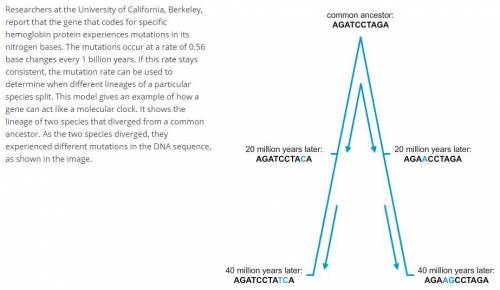
Biology, 25.04.2021 14:00 ashtonsilvers2003
Hello I really need help for this question, I don't understand what I am supposed to do! Thank you for help.
Molecular clock:
• Your timeline will span from 90 million years ago to the present. The common ancestor in your model is an arthropod that lived 90 million years ago. The gene that you’ll track codes for a protein in the species’ venom.
• The DNA sequence you’ll track contains 10 nitrogen bases. You can choose the order of the bases and where the mutations occur.
• This gene mutates at a rate of approximately 0.76 base pairs every 17.1 million years. To build your model, calculate the estimated time period it takes for 1 base pair to mutate.
• The first time period will only show the common ancestor. At the beginning of the second time period, three lineages will diverge from the common ancestor, each with a different mutation in their gene sequences.
• The first and third descendant species will survive for the rest of the timeline. The second descendant species was extinct 50 million years ago.
Question:
Using this sample model as a guide, create a molecular clock model. Use the flowchart tools in your word processing program to make your model. Make sure the mutations are clearly visible in the strand. Consider using a different font color for the mutations. Use the Insert Image button to insert a screenshot of your model in the answer space provided.


Answers: 1


Other questions on the subject: Biology


Biology, 22.06.2019 08:30, laurabwhiddon
Approximately percent of the energy created by cell metabolism is used by the body to carry on its normal functions, such as respiration, digestion, reproduction, muscular movement, circulation, and cellular regrowth.
Answers: 3

You know the right answer?
Hello I really need help for this question, I don't understand what I am supposed to do! Thank you f...
Questions in other subjects:

Mathematics, 23.06.2019 09:30



Mathematics, 23.06.2019 09:40





Social Studies, 23.06.2019 09:40



